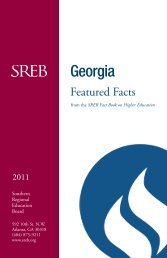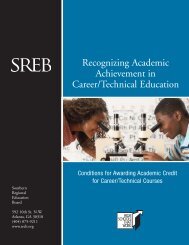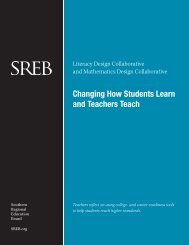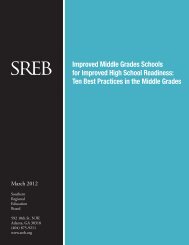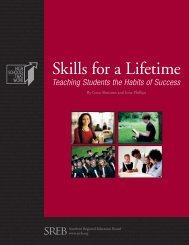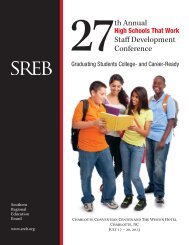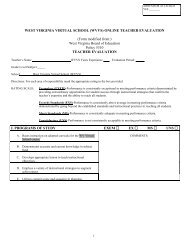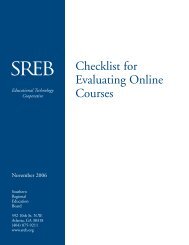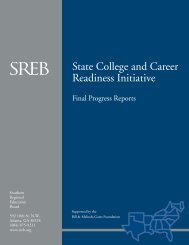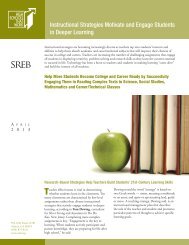HSTW-Recommended Curriculum• At least four college-preparatory English courses thatemphasize reading, writing and presentation skills — Studentsread the equivalent of eight books annually, write short papersweekly and write at least one research paper annually. Studentsrevise work until it meets standards.• At least four credits in mathematics, including Algebra I,geometry, Algebra II and a fourth higher-level mathematicscourse or a specially developed mathematics course designedto prepare students for postsecondary studies.• At least three college-preparatory science courses,including biology, chemistry, physics or applied physics, oranatomy/physiology — Students conduct lab experimentsand investigative studies; read, critique and discuss three tofive books or equivalent articles about scientists, scientificdiscoveries and real-world application of science; keep labnotebooks; make presentations; and complete researchprojects and written reports. Students design and conductgroup or individual projects. HSTW recommends that schoolsusing block schedules require four years of science.• At least three college-preparatory social studies coursesemphasizing reading and writing to learn — Students readfive to eight books or equivalent articles, write weekly, makepresentations, complete research projects, and prepare at leastone major research paper in each course.• A sequence of at least four credits in a concentration— Each student will have a choice of two academicconcentrations, such as mathematics/science and humanities,and a choice from among at least four career/technicalconcentrations at school sites, work sites, career/technicalcenters and/or postsecondary institutions.HSTW-Recommended ConcentrationsCareer/technical — four credits in a planned sequence of courses from a choice of at least four career/technical concentrationsMathematics and science — four credits in each field with at least one at the Advanced Placement levelHumanities — four credits each in college-preparatory/honors English and social studies, with at least one at the Advanced Placementlevel, and four additional credits from foreign language, fine arts, journalism, debate, etc.122 25th Annual Staff Development Conference
MMGW Goals for Continuous Improvement• Increase the percentages of students who meet the MMGW performance goals in reading, mathematics andscience on the Middle Grades Assessment (a NAEP-referenced exam) to 85 percent.• Increase the percentages of all students who perform at the Proficient level in reading, mathematics and science toat least 50 percent, as measured by the Middle Grades Assessment.• Increase annually the percentages of middle grades students entering high school prepared to succeed in collegepreparatorycourses.• Increase the percentages of middle grades students who transition into grade nine and complete high school fouryears later to 90 percent.• Reduce the failure rate in grade nine by ensuring middle grades students receive the preparation they need tosucceed in high school courses such as Algebra I and college-preparatory English and science.• Advance state and local policies and leadership initiatives that sustain a continuous school improvement effort.MMGW Key Practices for Improving Student Achievement• Aligned academic core — Provide rigorous content in allmiddle grades academic core classes, and align core classeswith performance standards that clearly state what studentsmust know, understand and be able to do to succeed incollege-preparatory English, mathematics and science coursesin high school. Enroll middle grades students in core curriculathat accelerate their learning, challenge them and appeal totheir interests.• Engaging classroom practices — Design classroom practicesand instructional strategies to engage students intellectually,emotionally, behaviorally and socially in learning rigorousacademic content. Young adolescents need varied learningactivities linked to challenging academic content andopportunities to use newly acquired skills and concepts inhands-on, real-world applications so that they can understandand explain their interests, talents and aspirations.• Literacy across the curriculum: Embed reading and writingstandards and strategies for learning into all courses to advanceacademic and reading achievement and to help studentsbecome independent learners. Provide reading instructionin all academic curricula through grade eight and utilizeresearch-based literacy strategies across content areas.• High expectations and a system of extra help and time —Hold students to grade-level standards aligned to readinessstandards for high school, college and careers. Organize timeand resources to ensure students receive the extra help neededto meet high standards and expectations. Middle gradesstudents learn in different ways and at different rates, andsome will need more time and help to meet more grade-levelstandards. The complete middle grades curriculum shouldbe focused on accelerating achievement for all students usingseveral strategies.• Intervention program for at-risk students — Identify at-riskstudents in grades six, seven and eight who need acceleratedinstruction in mathematics, language arts and reading to beprepared for college-preparatory high school course work, andimplement strategies and programs that target their needs.• Comprehensive system of guidance and advisement thatinvolves parents — Engage teachers, students and parentsin a comprehensive guidance and advisement system —including academic advisement, career exploration andeducational planning — that leads to a successful transitionto high school. Involve parents in the school improvementprocess by informing them of the school’s mission andassisting them to understand the higher standards ofperformance now required of middle grades students and tosupport students to make greater effort and work hard.• Teachers working together — Provide teams of teacherswith time and support to work together — within andacross disciplines — to integrate STEM (science, technology,engineering and mathematics) and literacy concepts acrossthe curriculum, analyze teacher assignments and studentwork, and help students succeed in challenging academic andexploratory studies.25th Annual Staff Development Conference 123
- Page 1 and 2:
TH25ANNUALHigh Schools That WorkS T
- Page 3 and 4:
ContentsConference Purpose and Obje
- Page 5 and 6:
Sessions by Objective and Sub-Objec
- Page 7 and 8:
Sessions by Objective and Sub-Objec
- Page 9 and 10:
Special InformationThank You, Tenne
- Page 11 and 12:
SREB/HSTW Publications Booth — Te
- Page 13 and 14:
Tips for Using This ProgramTips for
- Page 15 and 16:
Personal ScheduleFriday, July 22TIM
- Page 17 and 18:
P-10.Using a Six-Step Process to De
- Page 19 and 20:
WEDNESDAY 3 P.M.OPENING SESSIONWhat
- Page 21 and 22:
THURSDAY, 8 A.M.REGULAR SESSIONSREG
- Page 23 and 24:
THURSDAY, 8 A.M.REGULAR SESSIONSREG
- Page 25 and 26:
THURSDAY, 8 A.M.REGULAR SESSIONSREG
- Page 27 and 28:
THURSDAY, 9:30 A.M.120-MINUTE SESSI
- Page 29 and 30:
THURSDAY, 9:30 A.M.REGULAR SESSIONS
- Page 31 and 32:
THURSDAY, 9:30 A.M.MINI-SHARING SES
- Page 33 and 34:
THURSDAY, 11 A.M.REGULAR SESSIONSRE
- Page 35 and 36:
THURSDAY, 11 A.M.REGULAR SESSIONSRE
- Page 37 and 38:
THURSDAY, 11 A.M.REGULAR SESSIONSRE
- Page 39 and 40:
THURSDAY, 1 P.M.FEATURED PRESENTATI
- Page 41 and 42:
THURSDAY, 1 P.M.REGULAR SESSIONSREG
- Page 43 and 44:
THURSDAY, 1 P.M.REGULAR SESSIONSREG
- Page 45 and 46:
THURSDAY, 1 P.M.MINI-SHARING SESSIO
- Page 47 and 48:
THURSDAY, 2:15 P.M.REGULAR SESSIONS
- Page 49 and 50:
THURSDAY, 2:15 P.M.REGULAR SESSIONS
- Page 52 and 53:
THURSDAY, 3:30 P.M.FEATURED PRESENT
- Page 54 and 55:
THURSDAY, 3:30 P.M.REGULAR SESSIONS
- Page 56 and 57:
THURSDAY, 3:30 P.M.REGULAR SESSIONS
- Page 58 and 59:
FRIDAY, 8 A.M.FEATURED PRESENTATION
- Page 60 and 61:
FRIDAY, 8 A.M.REGULAR SESSIONSREGUL
- Page 62 and 63:
FRIDAY, 8 A.M.REGULAR SESSIONSREGUL
- Page 64 and 65:
FRIDAY, 9:30 A.M.FEATURED PRESENTAT
- Page 66 and 67:
FRIDAY, 9:30 A.M.REGULAR SESSIONSRE
- Page 68 and 69:
FRIDAY, 9:30 A.M.MINI-SHARING SESSI
- Page 70 and 71:
FRIDAY, 11 A.M.FEATURED PRESENTATIO
- Page 72 and 73:
FRIDAY, 11 A.M.REGULAR SESSIONSREGU
- Page 74 and 75: FRIDAY, 11 A.M.MINI-SHARING SESSION
- Page 76 and 77: FRIDAY, 1 P.M.FEATURED PRESENTATION
- Page 78 and 79: FRIDAY, 1 P.M.REGULAR SESSIONSREGUL
- Page 80 and 81: FRIDAY, 1 P.M.REGULAR SESSIONSMINI-
- Page 82 and 83: FRIDAY, 2:15 P.M.REGULAR SESSIONSRE
- Page 84 and 85: FRIDAY, 2:15 P.M.REGULAR SESSIONSRE
- Page 86 and 87: FRIDAY, 2:15 P.M.MINI-SHARING SESSI
- Page 88 and 89: FRIDAY, 3:30 P.M.REGULAR SESSIONSRE
- Page 90 and 91: FRIDAY, 3:30 P.M.REGULAR SESSIONSRE
- Page 92 and 93: SATURDAY, 8:30 A.M.REGULAR SESSIONS
- Page 94 and 95: SATURDAY, 8:30 A.M.REGULAR SESSIONS
- Page 96 and 97: PRESENTERS DIRECTORYFULL NAME ORGAN
- Page 98 and 99: PRESENTERS DIRECTORYFULL NAME ORGAN
- Page 100 and 101: PRESENTERS DIRECTORYFULL NAME ORGAN
- Page 102 and 103: PRESENTERS DIRECTORYFULL NAME ORGAN
- Page 104 and 105: PRESENTERS DIRECTORYFULL NAME ORGAN
- Page 106 and 107: PRESENTERS DIRECTORYFULL NAME ORGAN
- Page 108 and 109: PRESENTERS DIRECTORYFULL NAME ORGAN
- Page 110 and 111: PRESENTERS DIRECTORYFULL NAME ORGAN
- Page 112 and 113: PRESENTERS DIRECTORYFULL NAME ORGAN
- Page 114 and 115: PRESENTERS DIRECTORYFULL NAME ORGAN
- Page 116 and 117: PRESENTERS DIRECTORYFULL NAME ORGAN
- Page 118 and 119: EXHIBITORS AND THEIR BOOTH NUMBERSG
- Page 120 and 121: EXHIBITORS AND THEIR BOOTH NUMBERSS
- Page 122 and 123: School Improvement StaffGene Bottom
- Page 126 and 127: MMGW Key Practices for Improving St
- Page 128 and 129: 126 25th Annual Staff Development C
- Page 130 and 131: 128 25th Annual Staff Development C
- Page 132 and 133: Gaylord Opryland Resort and Convent
- Page 134 and 135: Gaylord Opryland Resort and Convent
- Page 136: (11V17)



